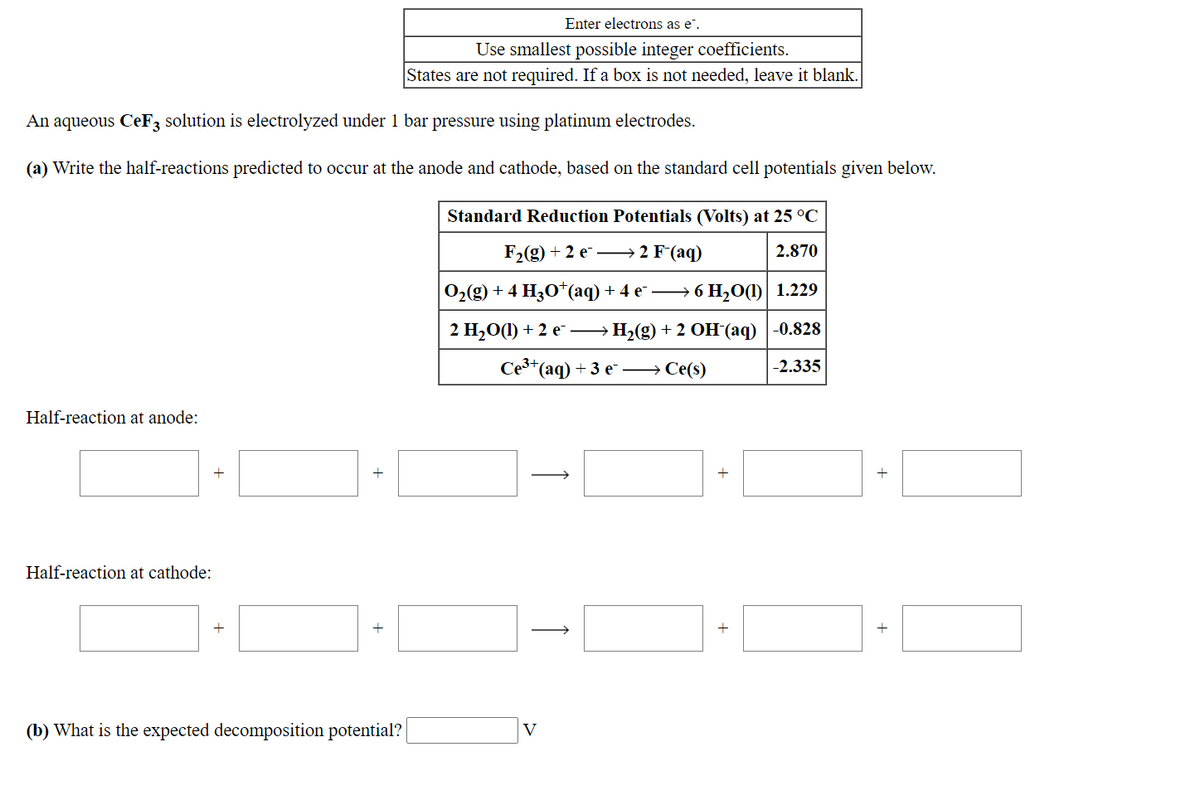Enter electrons as e". Use smallest possible integer coefficients. States are not required. If a box is not needed, leave it blank. An aqueous CEF3 solution is electrolyzed under 1 bar pressure using platinum electrodes. (a) Write the half-reactions predicted to occur at the anode and cathode, based on the standard cell potentials given below. Standard Reduction Potentials (Volts) at 25 °C F2(g) + 2 e¯ –→ 2 F°(aq) 2.870 02(g) + 4 H3O*(aq) + 4 e¯ –→ 6 H,O(1)| 1.229 2 H,0() + 2 е — Н:(9) + 2 ОН (аq) |-0.828| Се (aq) + 3 е — Се(9) -2.335 Half-reaction at anode:
Enter electrons as e". Use smallest possible integer coefficients. States are not required. If a box is not needed, leave it blank. An aqueous CEF3 solution is electrolyzed under 1 bar pressure using platinum electrodes. (a) Write the half-reactions predicted to occur at the anode and cathode, based on the standard cell potentials given below. Standard Reduction Potentials (Volts) at 25 °C F2(g) + 2 e¯ –→ 2 F°(aq) 2.870 02(g) + 4 H3O*(aq) + 4 e¯ –→ 6 H,O(1)| 1.229 2 H,0() + 2 е — Н:(9) + 2 ОН (аq) |-0.828| Се (aq) + 3 е — Се(9) -2.335 Half-reaction at anode:
Chemistry: Principles and Practice
3rd Edition
ISBN:9780534420123
Author:Daniel L. Reger, Scott R. Goode, David W. Ball, Edward Mercer
Publisher:Daniel L. Reger, Scott R. Goode, David W. Ball, Edward Mercer
Chapter18: Electrochemistry
Section: Chapter Questions
Problem 18.50QE
Related questions
Question

Transcribed Image Text:Enter electrons as e".
Use smallest possible integer coefficients.
States are not required. If a box is not needed, leave it blank.
An aqueous CeF3 solution is electrolyzed under 1 bar pressure using platinum electrodes.
(a) Write the half-reactions predicted to occur at the anode and cathode, based on the standard cell potentials given below.
Standard Reduction Potentials (Volts) at 25 °C
F-(g) + 2 е —2 F(aq)
2.870
0(g) + 4 H,О*(aq) + 4 e — 6 H,0()| 1.229
2 Н,О() + 2 е —
H2(g) + 2 OH (aq) |-0.828
Сез-(аq) + 3 е — Се(9)
-2.335
Half-reaction at anode:
+
Half-reaction at cathode:
(b) What is the expected decomposition potential?
V
Expert Solution
This question has been solved!
Explore an expertly crafted, step-by-step solution for a thorough understanding of key concepts.
This is a popular solution!
Trending now
This is a popular solution!
Step by step
Solved in 2 steps

Knowledge Booster
Learn more about
Need a deep-dive on the concept behind this application? Look no further. Learn more about this topic, chemistry and related others by exploring similar questions and additional content below.Recommended textbooks for you

Chemistry: Principles and Practice
Chemistry
ISBN:
9780534420123
Author:
Daniel L. Reger, Scott R. Goode, David W. Ball, Edward Mercer
Publisher:
Cengage Learning

Principles of Modern Chemistry
Chemistry
ISBN:
9781305079113
Author:
David W. Oxtoby, H. Pat Gillis, Laurie J. Butler
Publisher:
Cengage Learning

Chemistry & Chemical Reactivity
Chemistry
ISBN:
9781337399074
Author:
John C. Kotz, Paul M. Treichel, John Townsend, David Treichel
Publisher:
Cengage Learning

Chemistry: Principles and Practice
Chemistry
ISBN:
9780534420123
Author:
Daniel L. Reger, Scott R. Goode, David W. Ball, Edward Mercer
Publisher:
Cengage Learning

Principles of Modern Chemistry
Chemistry
ISBN:
9781305079113
Author:
David W. Oxtoby, H. Pat Gillis, Laurie J. Butler
Publisher:
Cengage Learning

Chemistry & Chemical Reactivity
Chemistry
ISBN:
9781337399074
Author:
John C. Kotz, Paul M. Treichel, John Townsend, David Treichel
Publisher:
Cengage Learning

Chemical Principles in the Laboratory
Chemistry
ISBN:
9781305264434
Author:
Emil Slowinski, Wayne C. Wolsey, Robert Rossi
Publisher:
Brooks Cole

Chemistry: The Molecular Science
Chemistry
ISBN:
9781285199047
Author:
John W. Moore, Conrad L. Stanitski
Publisher:
Cengage Learning

Chemistry
Chemistry
ISBN:
9781305957404
Author:
Steven S. Zumdahl, Susan A. Zumdahl, Donald J. DeCoste
Publisher:
Cengage Learning